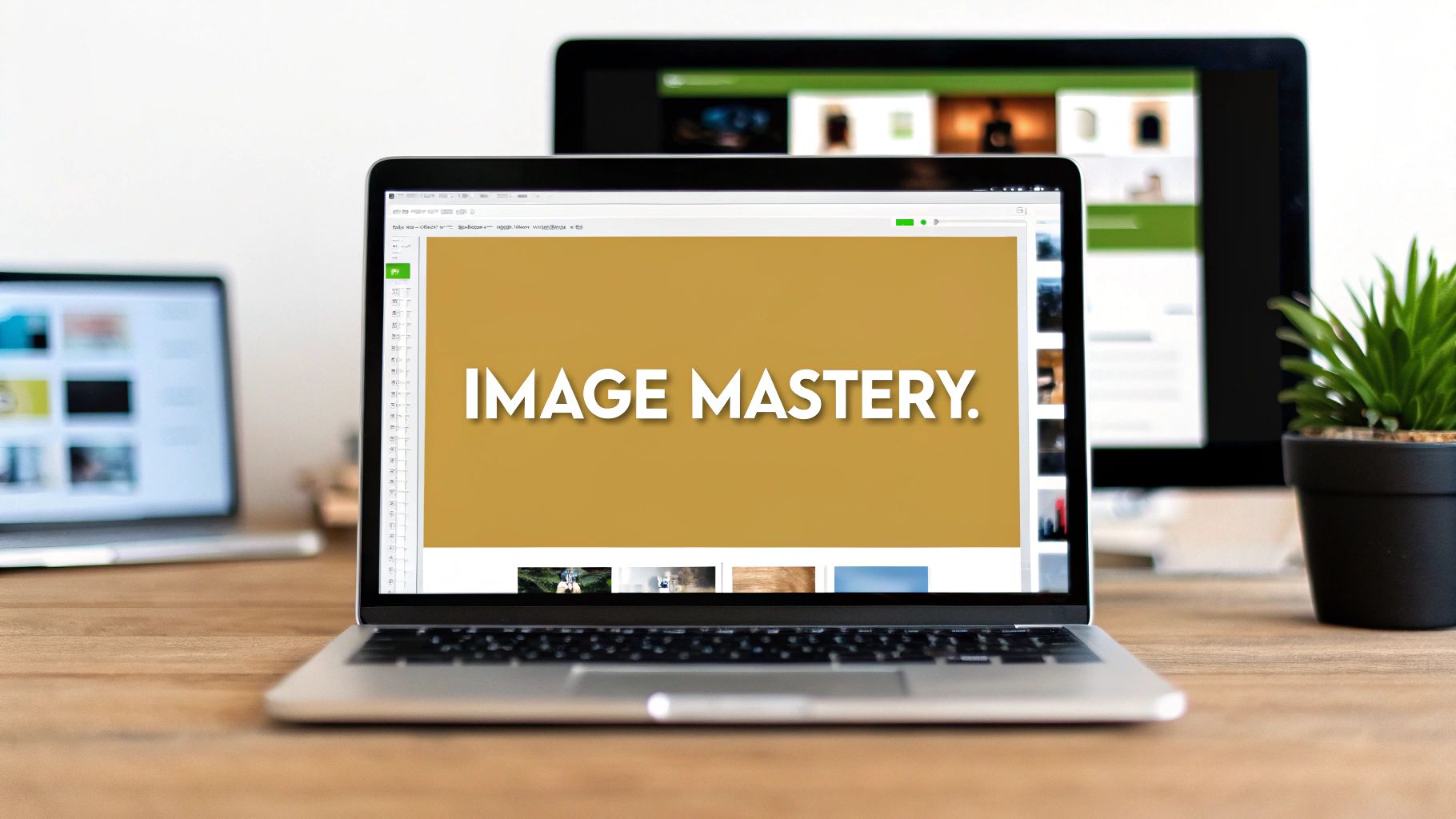Essential Shopify Product Image Size Guidelines
Getting your product images right on Shopify can seem a bit daunting, but understanding the ideal sizes is really important for a successful online store. It's not just about making things look pretty; it’s about finding the sweet spot between attractive visuals and a fast, user-friendly website. Your Shopify product image size affects everything from how the zoom function works and how well your site adapts to mobile screens, all the way to how many visitors actually buy something.
Why Shopify Product Image Size Matters
Choosing the right image size ensures your products shine on any device. This means sharp, clear pictures on big desktop monitors and equally crisp details on smaller mobile screens. Imagine trying to check out a beautiful necklace on your phone, only to see a blurry, pixelated mess. That kind of bad experience can easily lead to lost sales. Plus, large, clunky images can really slow down your website, annoying customers and hurting your search engine rankings.
Shopify's Recommended Image Sizes
So, what size should you aim for? Shopify suggests specific dimensions for product images to get the best balance between quality and performance. They recommend a size between 800 x 800 pixels and 2048 x 2048 pixels for square product images. Shopify lets you upload images as big as 5000 x 5000 pixels with file sizes up to 20 MB, but 2048 x 2048 pixels is usually the best option for square images. This size gives you great resolution without slowing things down. Explore this topic further
This size also works well with the zoom feature on product pages. Customers can zoom in to see all the details, which makes for a much better shopping experience. Shopify’s focus on the 2048 x 2048 size shows how they’re trying to balance high-quality visuals with a smooth website experience. Larger images can bog down loading times, which impacts both customer satisfaction and how well your site performs in search results. These recommendations are good to keep in mind, especially in competitive online markets where user experience directly affects sales.
Aspect Ratios and Image Dimensions
While Shopify recommends a maximum size, aspect ratio is just as important. Aspect ratio is simply the relationship between an image’s width and height. Shopify suggests a 1:1 aspect ratio for product images, meaning the width and height should be the same (a square). This keeps your product catalog looking neat and consistent, and avoids weird cropping or stretching when images are displayed on different screens.
Practical Tips for Optimizing Shopify Product Images
- Prioritize the 2048 x 2048 Pixel Size: This is the goldilocks size—not too big, not too small.
- Maintain a 1:1 Aspect Ratio: Your images will look much better across the board.
- Use High-Quality Images: Professional photography can make a big difference.
- Optimize Image File Size: Compress your images to make them smaller without losing too much quality. TinyPNG is a handy tool for this.
- Name Your Images Descriptively: This helps with search engine optimization (SEO).
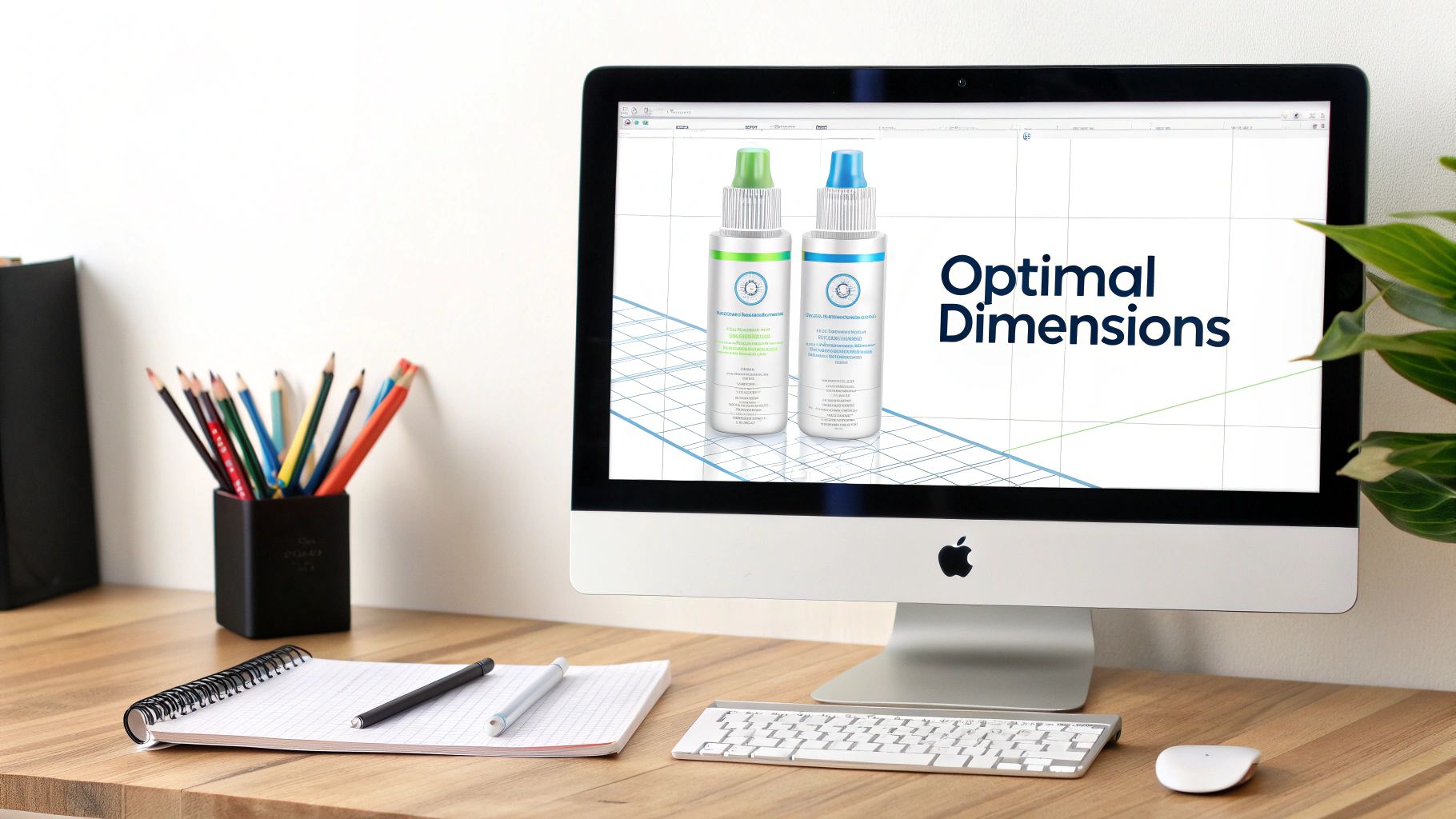
By following these guidelines, your Shopify product images will look sharp, load quickly, and create a better shopping experience that encourages customers to buy. This helps boost sales and strengthens your brand.
Quality vs. Speed: Finding Your Store's Sweet Spot
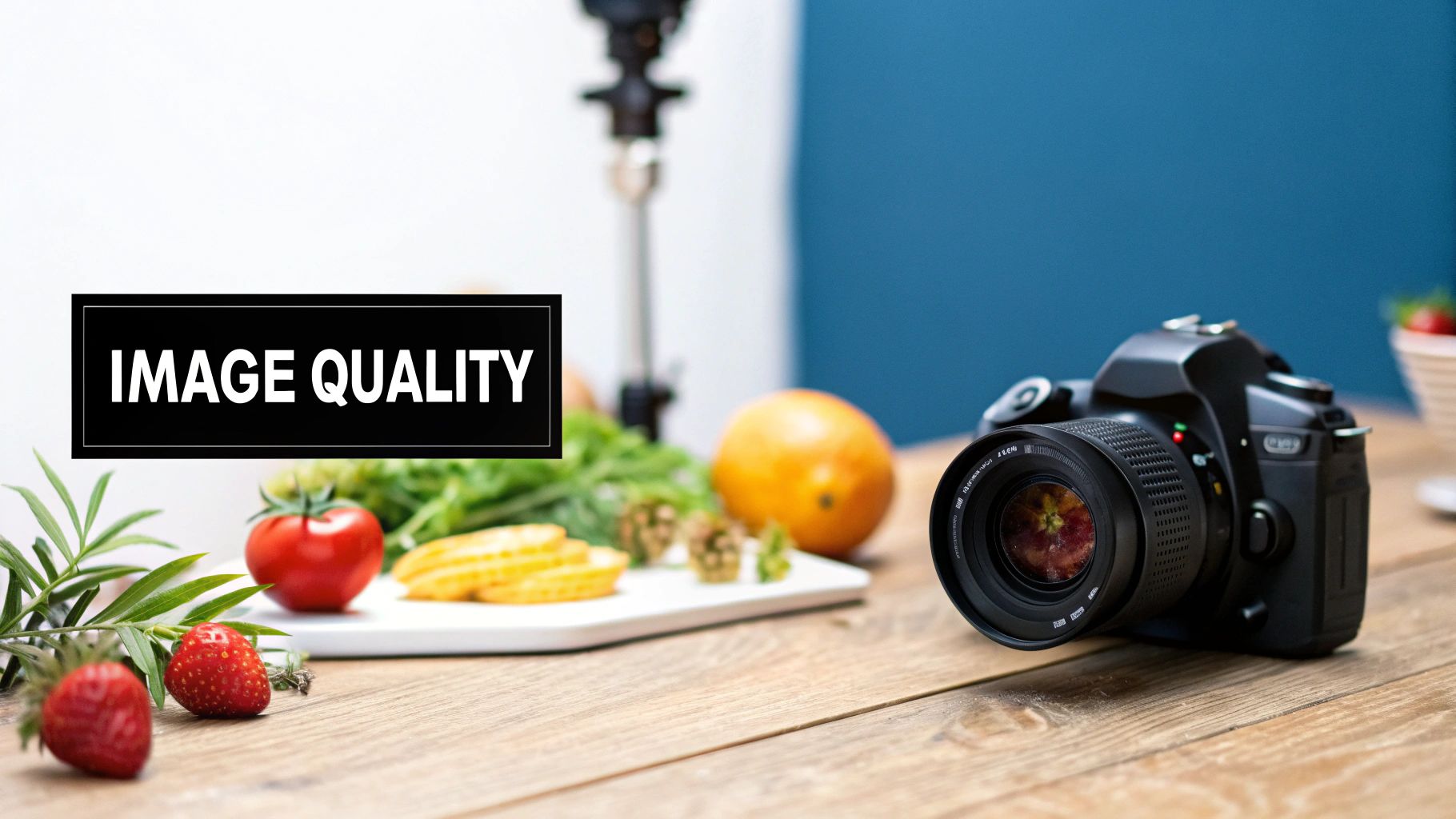
Attractive product images are essential for any successful Shopify store. But so too are fast loading speeds. Balancing these two critical elements directly impacts your bottom line. A beautiful photo that takes ages to load can lose potential customers just as quickly as a blurry thumbnail.
The Impact of Image Optimization on Conversions
Imagine a customer trying to see the details of a handcrafted bracelet. A slow-loading, pixelated image can quickly lead to frustration. This poor user experience can result in abandoned carts and lost sales. This is why optimizing your Shopify product image size is so important. Finding the right balance can dramatically improve key metrics like bounce rates and time-on-site, ultimately boosting sales performance.
Choosing the right Shopify product image size isn’t just a technical detail. It’s a vital part of your conversion strategy. Check out this guide on How to master Shopify Conversion Optimization.
Different Products, Different Approaches
The best Shopify product image size varies depending on the product. A simple t-shirt doesn't need the same level of detail as a complex piece of machinery. Understanding these differences lets you tailor your image optimization strategy for maximum impact. Image size impacts site speed, user experience, and sales. The ideal product image size for optimal site speed is around 500 x 500 pixels. This is especially beneficial for mobile users and stores with many products.
The file format also plays a crucial role. While PNG images are good for graphics because of their lossless compression and transparency, JPEG format is better for product photos. JPEGs can be up to 5 times smaller than PNGs, significantly reducing load times. Many Shopify users upload JPEGs sized between 800 x 800 and 2048 x 2048 pixels to balance quality and performance.
Let's look at how image size can affect your store:
Image Size Impact on Shopify Store Performance
| Image Size | Avg. Load Time | Mobile Performance | Zoom Quality | Recommended For |
|---|---|---|---|---|
| 500 x 500 px | Fastest | Best | Lower | Mobile and large catalogs |
| 800 x 800 px | Moderate | Good | Moderate | Balancing speed and quality |
| 2048 x 2048 px | Slowest | Poor | Highest | Detailed product views |
This table highlights the trade-offs between different image sizes. Smaller images load faster on mobile, while larger images provide better zoom quality but can slow down your site. Choosing the right size depends on your priorities. For more insights, see this discussion: What is the ideal product image size for optimal site speed?
The Mobile Optimization Challenge
Mobile commerce adds another layer to image optimization. Smaller screens and often slower internet connections mean images must load quickly and display clearly on mobile devices. Successful Shopify stores prioritize mobile optimization.
Finding the Sweet Spot
Finding the right balance between quality and speed depends on understanding your product and target audience. For products with intricate details, higher-resolution images are essential. However, even large images need file size optimization through compression to maintain fast loading times. You might find this helpful: How to increase Shopify sales. By using best practices for image compression and choosing the right file format, you can deliver great visuals without sacrificing performance.
Category-Specific Image Dimensions That Drive Sales
Different products require different visual strategies. What effectively showcases clothing won't necessarily work for jewelry. Understanding category-specific image needs is crucial for driving sales on your Shopify store. Let's explore how different niches can leverage Shopify product image size to their advantage.
Fashion and Apparel
Fashion thrives on showcasing fit, drape, and detail. Images need to present these elements clearly. A common approach is to use a taller aspect ratio than the standard 1:1 square, such as 2:3 or 4:5, particularly for full-body shots. This allows for a more complete view of the garment on a model or mannequin. Close-ups should still prioritize high resolution to allow customers to zoom in and examine textures and stitching.
Jewelry and Accessories
For jewelry, capturing minute details is paramount. High-resolution images are essential to showcase the intricacies of gemstones, metalwork, and design. Zooming capability becomes even more critical, as customers often scrutinize the smallest details before purchasing. A 1:1 aspect ratio can be effective for individual product shots. Consider lifestyle images with varying aspect ratios to show how the jewelry looks when worn. Historically, merchants often uploaded high-resolution images around 1500 x 1500 pixels with file sizes around 200 KB each for optimal detail. Learn more about optimal Shopify product image sizes here.
Electronics and Gadgets
Electronics require images that clearly display features, functionality, and size. Multiple angles are often necessary to convey the product's dimensions and highlight key components. Use a mix of lifestyle images and product-focused shots to showcase the gadget in use and illustrate its size relative to everyday objects. Consistent lighting and backgrounds are crucial for a professional and clean look.
Beauty and Cosmetics
Beauty products benefit from high-quality images that accurately represent color, texture, and application. Close-ups are crucial to showcase the product's finish and consistency. Incorporate lifestyle images to demonstrate how the product looks when applied. Videos can showcase application techniques or tutorials. You might be interested in: How to increase sales on Shopify.
Home Decor and Furniture
For home decor and furniture, lifestyle images are essential. Showcasing the product in a styled setting helps customers visualize how it would look in their homes. Use a variety of aspect ratios to capture the product's overall form and scale, along with close-ups to highlight textures and details.
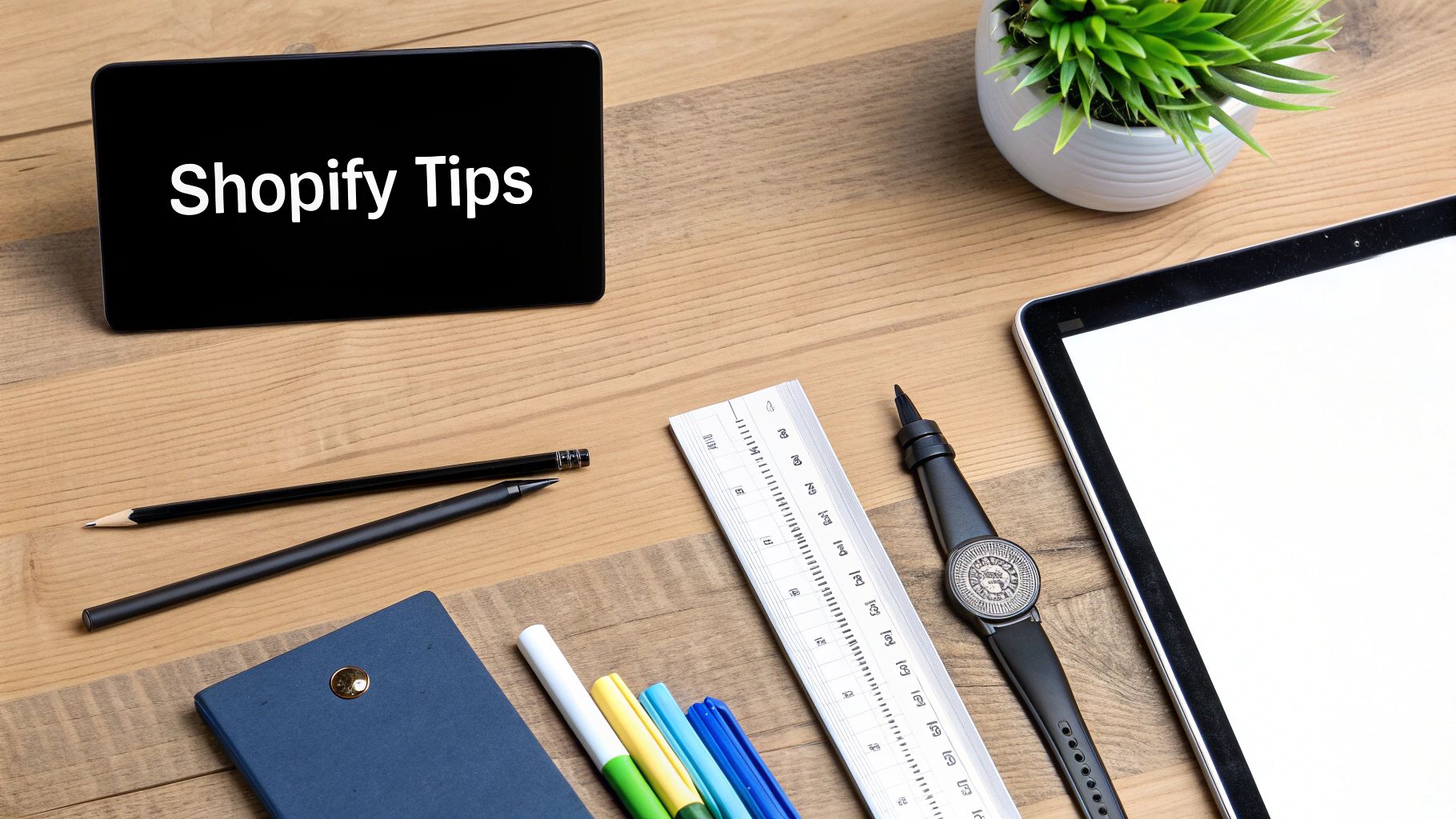
Maintaining Visual Consistency
While category-specific considerations are essential, maintaining a consistent visual style across your Shopify store is equally important. This means using consistent lighting, backgrounds, and editing styles for all product categories. This creates a cohesive brand image and improves the overall user experience. Implementing a style guide for your product photography can help ensure consistency across your entire product catalog.
Mastering File Formats for Maximum Performance
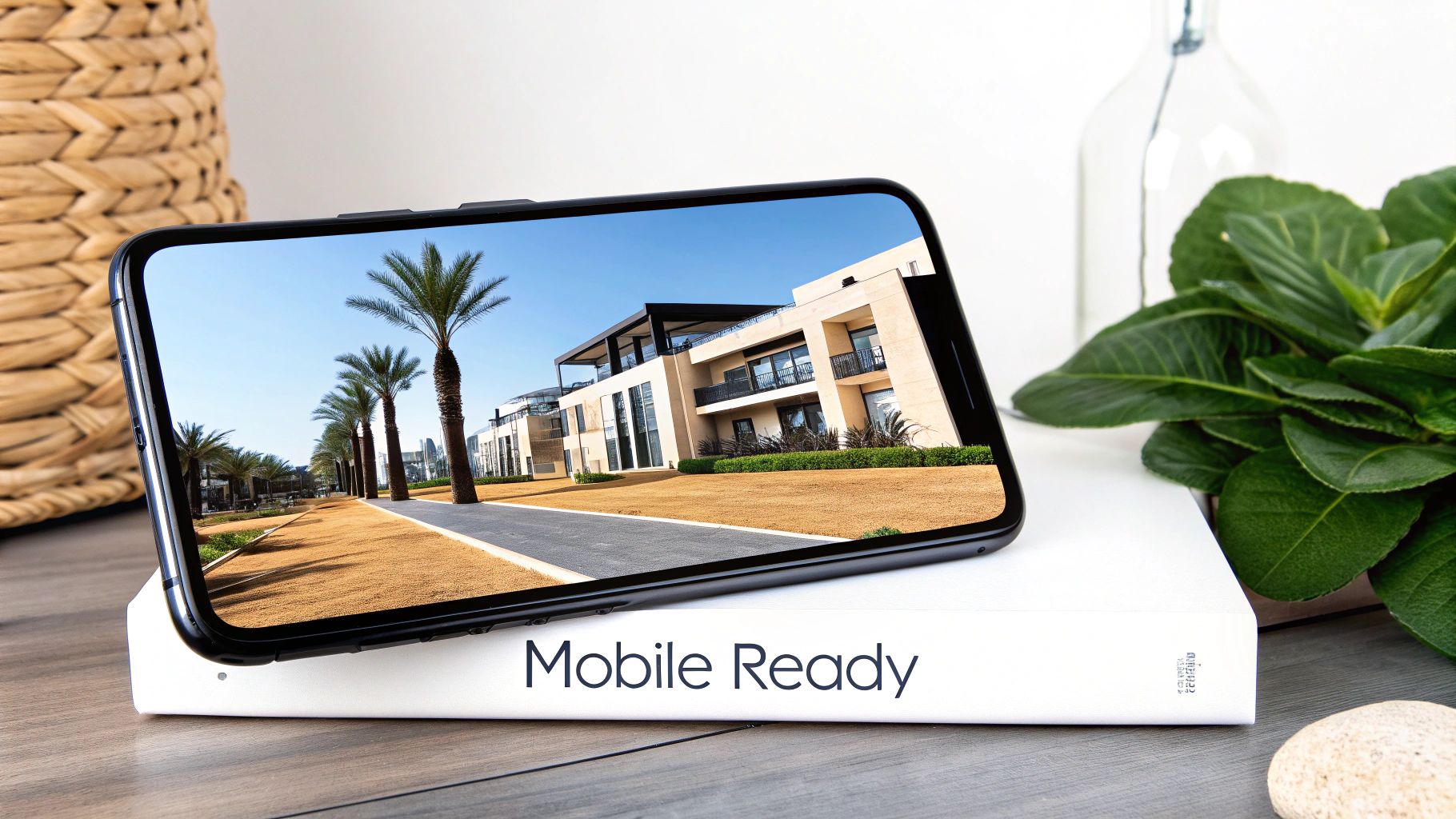
Optimizing your Shopify product images goes beyond just resizing. The file format you choose has a big impact on how your products look and how quickly your store loads. This, in turn, can significantly affect your conversion rates.
This section explains the best image formats for Shopify and how to use them effectively.
Common Image Formats for Shopify
The most frequently used image formats on Shopify are JPEG, PNG, and WebP. Each format has its own pros and cons, making it suitable for different image types. Picking the right one is all about balancing quality with file size.
-
JPEG (JPG): This format is a staple for product photography. JPEG uses lossy compression, which means some image data is lost to shrink the file size. This makes JPEGs great for photos with lots of colors and textures, offering a good compromise between quality and size. However, too much compression can make the image look blurry or pixelated.
-
PNG: PNG uses lossless compression, meaning no image data is lost. This is perfect for images with sharp lines, text, or graphics, where detail is important. PNG also supports transparency, essential for logos and images with transparent backgrounds. The downside is that PNG files are often larger than JPEGs, potentially slowing down loading times.
-
WebP: This newer format offers both lossy and lossless compression. It often creates smaller files than JPEG or PNG while maintaining, and sometimes even improving, image quality. WebP also supports transparency. However, some older browsers may not support WebP, so make sure your theme has a fallback option.
Choosing The Right Format for Your Products
The best format depends on the image. For product photos, JPEG is usually the best choice because of its smaller file size. But if you need to keep fine details or have a transparent background, PNG is the way to go. For logos, graphics, and other images where transparency is key, PNG is recommended. If your customers mostly use up-to-date browsers, WebP is the most efficient way to get the best quality and smallest file size.
Compression and Optimization
No matter which format you choose, compressing your images is essential. Even small file size reductions can make a big difference, especially if you have lots of products. There are many free and paid tools, like the popular TinyPNG, that can compress images without losing too much quality. TinyPNG is an easy way to optimize both JPEG and PNG files.
Let's look at a table summarizing the key differences between these formats.
To help you understand the differences between these image formats and choose the right one for your Shopify store, take a look at the following table:
Shopify-Compatible Image Formats Comparison
| Format | Best For | Compression Type | Transparency Support | File Size | Browser Compatibility |
|---|---|---|---|---|---|
| JPEG | Product Photos | Lossy | No | Small | Excellent |
| PNG | Logos, Graphics | Lossless | Yes | Larger | Excellent |
| WebP | All Image Types | Lossy/Lossless | Yes | Smallest | Good (Modern Browsers) |
This table breaks down the key differences between the image formats. Knowing these differences helps you make the right choices for your Shopify product images. By choosing the correct format and optimizing your images, your products will look great and your customers will enjoy a fast, smooth shopping experience.
Your Step-by-Step Image Optimization Workflow
Turning basic product photos into polished, high-converting images for your Shopify store takes a systematic approach. This workflow will guide you through each step, making sure your images look professional and load quickly.
Capture High-Quality Source Images
Start with the best possible source material. Good lighting and a clean, uncluttered background are essential. A 1:1 aspect ratio, or square images, is recommended for Shopify product images. This consistency creates a visually appealing product catalog and avoids awkward cropping.
Resize and Crop for Shopify
Next, resize your images to Shopify's recommended dimensions. While Shopify can handle large image uploads, aiming for 2048 x 2048 pixels strikes a balance between quality and file size. This ensures detailed zoom views without sacrificing loading speed. Think of it like choosing the right screen resolution—larger isn't always better if it affects performance. Remember to maintain that important 1:1 aspect ratio!
Choose the Optimal File Format
The right file format is crucial for performance. For most product photography, JPEG provides the best balance between quality and file size. Its lossy compression reduces image data slightly, resulting in smaller files. For images with sharp lines, text, or transparent backgrounds, PNG's lossless compression is a better choice. WebP is quickly becoming a popular option, offering excellent compression and quality.
Compress for Speed
Even after resizing, additional compression is key. Tools like TinyPNG are excellent for reducing file sizes without significantly affecting image quality. This step is like efficiently packing a suitcase—you can fit the same amount of clothes (image data) in a smaller bag (file size).
Name Your Images Strategically
Use descriptive file names that incorporate relevant keywords. For example, instead of "IMG_1234.jpg," use "blue-cotton-t-shirt.jpg." This simple step boosts your search engine optimization (SEO).
Implement a Consistent Workflow
Here are some tips for streamlining your image optimization:
- Batch Processing: Use image editing software like Adobe Photoshop that lets you resize, crop, compress, and rename multiple images simultaneously. This saves significant time, especially for large catalogs.
- Naming Conventions: Establish a standard naming system for all product images, including variations, such as "blue-cotton-t-shirt-front.jpg," "blue-cotton-t-shirt-back.jpg," and "blue-cotton-t-shirt-detail.jpg." This helps with organization and management.
- Automation: Explore tools that automate elements of this workflow, like automatic resizing and compression upon upload. This ensures consistency and frees up your time. For more information on improving eCommerce sales, check out this helpful guide: Improve Your eCommerce Sales
Example: Optimizing a T-Shirt Image
Let's walk through an example:
- Capture: Take a photo of a blue t-shirt against a white background with proper lighting.
- Resize and Crop: Crop the image to a 1:1 aspect ratio and resize it to 2048 x 2048 pixels.
- Format: Save the image as a JPEG.
- Compress: Use TinyPNG to further reduce the file size.
- Name: Save the image as "blue-cotton-t-shirt-front.jpg."
Following these steps creates optimized images that will attract customers and improve your Shopify store's performance. A streamlined workflow ensures your images always look their best while maintaining quick loading speeds.
Advanced Techniques: Beyond Basic Optimization
Now that we’ve covered the basics of Shopify product image size, let’s explore some more advanced optimization strategies. These techniques can give your Shopify store a real performance boost, creating a smoother experience for your customers and, ultimately, driving more sales.
Responsive Images for Seamless Cross-Device Experiences
Responsive images are essential for any modern website. They allow your online store to automatically deliver the right sized image to each visitor based on their device. This means a smaller, optimized image is served to mobile users, while desktop viewers receive a larger, high-resolution image. Imagine having different versions of your product photos, each perfectly sized for a specific screen. This approach dramatically improves mobile performance without compromising image quality on larger screens. Learn More about Responsive Images
Leveraging Shopify’s CDN for Global Reach
Shopify’s Content Delivery Network (CDN) is a powerful tool that distributes your store's content, including images, across a network of servers around the world. This ensures that no matter where your customers are, they receive images from a server located nearby. The result? Faster loading times. For businesses with a global audience, a CDN is a must-have for creating a positive user experience. Shopify's CDN operates behind the scenes, quietly optimizing image delivery much like a well-organized shipping network ensures packages arrive quickly.
Implementing Lazy Loading for Improved Perceived Load Times
Lazy loading is a technique that delays the loading of images until they're actually needed. Images located below the fold (the part of the page initially hidden from view) are only loaded when the user scrolls down to them. This prioritizes the loading of the most important content first, dramatically improving the perceived load time. Think of it like a restaurant serving the main course before the side dishes – the overall dining experience feels much quicker. Lazy loading can improve perceived load times by up to 300%. Learn more about Lazy Loading on images
Performance Auditing for Data-Driven Optimization
For the more technically minded Shopify merchants, performance auditing tools like Google PageSpeed Insights and GTmetrix can help pinpoint image-related issues impacting conversion rates. These tools provide a thorough analysis of your site’s speed, offering practical recommendations for improvement. It’s like a health checkup for your online store, highlighting areas that need attention.
Emerging Image Technologies and the Future of E-Commerce
The world of e-commerce visuals is constantly evolving. New image formats like AVIF provide superior compression and quality compared to older formats like WebP, further optimizing image delivery. Technologies like 3D modeling and augmented reality (AR) are also changing the way customers interact with products online. Staying informed about these advancements will help keep your store ahead of the competition.
Looking to enhance your Shopify store’s link-in-bio experience? LinkShop creates attractive, shoppable link-in-bio pages tailored for Shopify merchants. It provides a more powerful alternative to Linkpop, giving you increased control and versatility. Learn more: LinkShop
